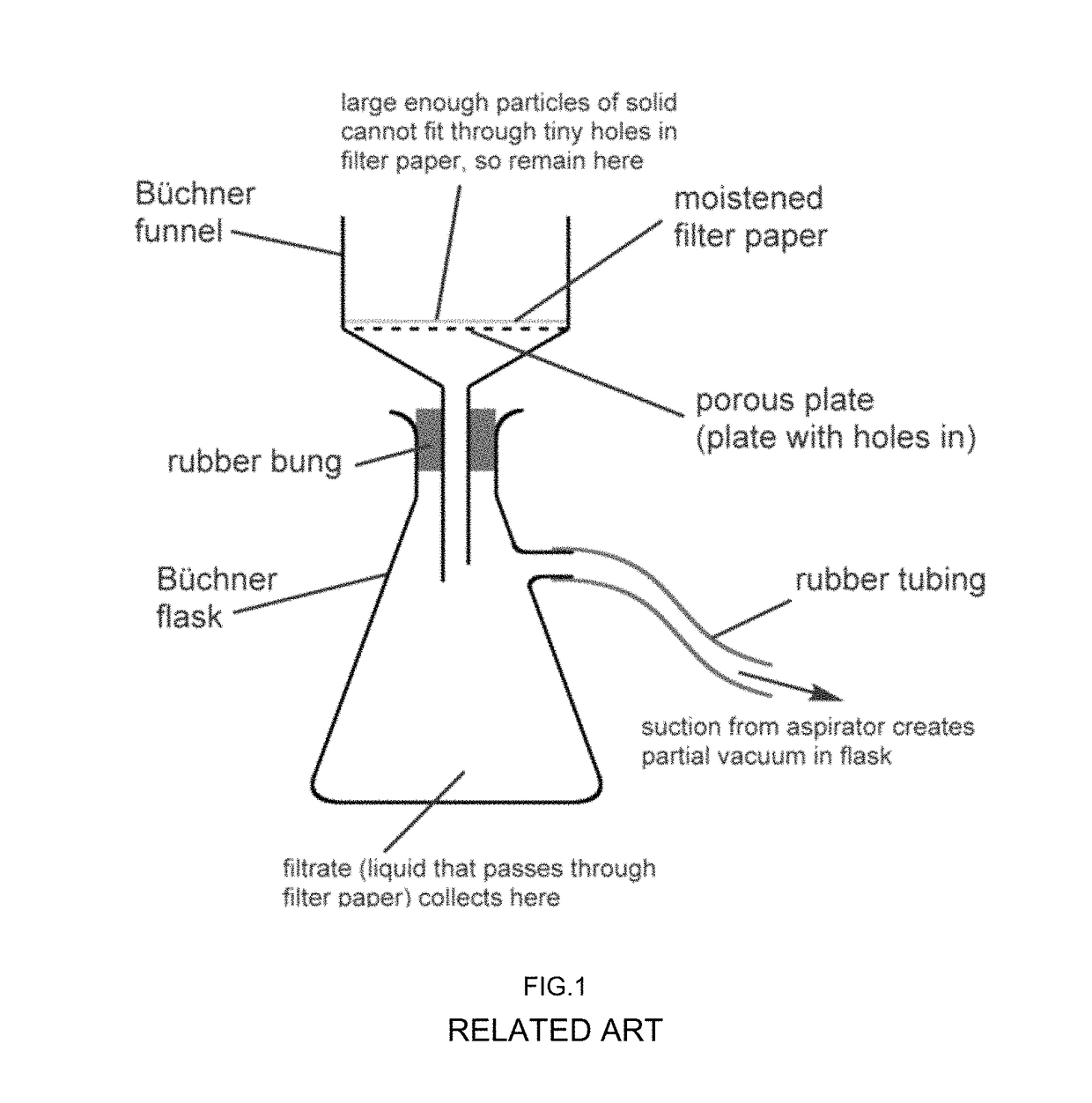Device for preparing biological samples
a biological sample and device technology, applied in the field of microbiological analysis, can solve the problems of difficult collection of particles of interest or microorganisms retained on the filter paper, inability to achieve optimal concentration ratio, and rapid blockage of filters, so as to simplify the process of filtration of biological samples, the effect of limiting the adhesion to the wall and easy us
- Summary
- Abstract
- Description
- Claims
- Application Information
AI Technical Summary
Benefits of technology
Problems solved by technology
Method used
Image
Examples
example 1
ts in Inoculated Urine: Results on Three Microorganisms in Automatic Mode
[0186]Microorganisms EC (Escherichia coli), SE (Staphylococcus epidermidis) and CA (Candida albicans).
[0187]
TABLE 3Yield of recovery (%) of the microorganismsE.C, S.E and C.A on several replicatesMOReplicateECSECA110037122784420388351849240959138867715
[0188]The yield is defined as the ratio of the amount of microorganisms recovered on the membrane at the end of the protocol to the amount of microorganisms introduced in solution on the prefilter.
[0189]This experiment, illustrated in FIG. 17, makes it possible to conclude that the device according to the invention is operating correctly. It makes it possible to effectively filter 10 ml of urine and to collect a not insignificant fraction of the microorganisms therefrom.
example 2
ts in Inoculated Healthy Urine: On Automated Pipetting Device (4 Parallel Devices)
[0190]Filtration yield on the EC (Escherichia coli) and CA (Candida albicans) microorganisms for various resuspension configurations (volume and distance to the vertical of the filter).
[0191]
Average yield on4 samplesECCASmall-volume jet69%29%and distance 1 mmSmall-volume jet59%and distance 3 mmLarge-volume jet73%27%and distance 3 mmLarge-volume jet59%and distance 5 mmManual reference82%
[0192]Table 4 showing the yield of recovery of the microorganisms E.C and C.A on several replicates while varying the automated resuspension method
[0193]This experiment made it possible to come to a conclusion regarding the feasibility of automation of the device and regarding the impact of the type of resuspension on the recovery yield.
Example 3: Experiment with Pathological Urine: Results of Detection of E. coli Peptides by LC-ESI MS (MRM Mode)
[0194]A batch of fifteen pathological urines was treated by double filtratio...
example 4
t with Inoculated Blood Cultures: Results of Peptide Detection by LC-ESI MS (MRM Mode)
[0215]The lysis-filtration protocol consists briefly of a selective lysis of the blood cells by action of a buffer containing a surfactant for a short period of time.
[0216]The advantage provided by the device described herein is by virtue of its geometry, in this case an incline of the filtering means of the collecting tank of 30°, which allows effective harvesting of the microorganisms by means of a liquid solution which finally results in a bacterial suspension.
[0217]The lysis-filtration protocol is the following:[0218]The filtration is carried out on a 0.2 μm PES filtration membrane used as filtering means of the collecting tank on the device according to the invention.[0219]The test sample is 0.8 ml of blood culture which is treated with 0.4 ml of 0.3 M CAPS buffer / 0.45% Brij for 2 minutes, followed by filtration for 2 minutes.[0220]3 washes with 175 μl of wash buffer 1 (0.45% NaCl / 0.005% Brij ...
PUM
| Property | Measurement | Unit |
|---|---|---|
| pore size | aaaaa | aaaaa |
| pore size | aaaaa | aaaaa |
| pore size | aaaaa | aaaaa |
Abstract
Description
Claims
Application Information
 Login to View More
Login to View More - R&D
- Intellectual Property
- Life Sciences
- Materials
- Tech Scout
- Unparalleled Data Quality
- Higher Quality Content
- 60% Fewer Hallucinations
Browse by: Latest US Patents, China's latest patents, Technical Efficacy Thesaurus, Application Domain, Technology Topic, Popular Technical Reports.
© 2025 PatSnap. All rights reserved.Legal|Privacy policy|Modern Slavery Act Transparency Statement|Sitemap|About US| Contact US: help@patsnap.com



